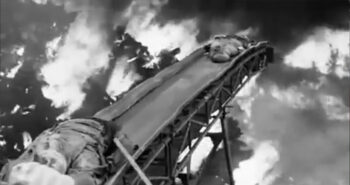Schindler’s List, movie
The 1993 movie Schindler’s List, directed by Jewish-American director Steven Spielberg, is loosely based on Thomas Keneally’s novel Schindler’s Arc. The imprint of the 1982 edition of this book states:
“This book is a work of fiction. Names, places, and incidents are either products of the author’s imagination or are used fictitiously. Any resemblance to actual events or locales or persons, living or dead, is entirely coincidental.”
This remark, which was not entirely true, was probably a mere legal precaution that was removed in later editions after Spielberg’s film made the book famous. Some of the central characters and places in the novel did, of course, exist, first and foremost the German entrepreneur Oskar Schindler, who had Jewish slave laborers working in his company, and the camp commandant Amon Göth as well as the two camps Auschwitz and Płaszow.
However, over the years, even orthodox historians have pointed out that the story line of both Keneally’s book and Spielberg’s movie drastically deviates from historical reality. Spielberg openly admitted that he deliberately shot his movie in black and white and created unsteady camera effects to suggest it is a documentary of its time.
According to the movie, the German commandant Amon Göth of the Płaszow Camp randomly shot prisoners from his home balcony overlooking the camp. According to air photos made at that time, however, the commandant’s home was situated at the foot of a rise, with the camp itself located on top of this rise. Hence the scene depicted in the movie was physically impossible.

In another movie scene, a conveyor belt is seen transporting corpses toward a burning fire in a pit, dumping them into the blaze (see the illustration). While such a scenario may show what many people came to expect when it comes to the Holocaust – with the orthodox narrative speaking incessantly about a highly industrialized, conveyor-belt style mass extermination – such a device has never been attested to by anyone.
The fact that Amon Göth was arrested and prosecuted by the SS-internal court system during the war is of course not mentioned in the movie.
Finally, the glorification of Schindler as the savior of “his” slave laborers misses the point. It is true that many Jews who were deployed to work in subcamps or in companies outside the concentration camps often suffered a milder fate than prisoners who were forced to linger in the large concentration camps themselves. However, the assertion that Jews interned at Auschwitz or Płaszów and their subcamps, whether they were fit for work or not, were at risk of physical extermination, is precisely the fictional aspect of Keneally’s work. However, it is not the product of his own imagination, but that of many witnesses and the orthodox narrative based on it. Without this gruesome yet false background, Keneally’s book and Spielberg’s film would never have been successful.
(For more details, see the entries on Amon Göth, Healthcare, Selections, and Monowitz as well as Rudolf 2024a, pp. 247f.)

You need to be a registered user, logged into your account, and your comment must comply with our Acceptable Use Policy, for your comment to get published. (Click here to log in or register.)